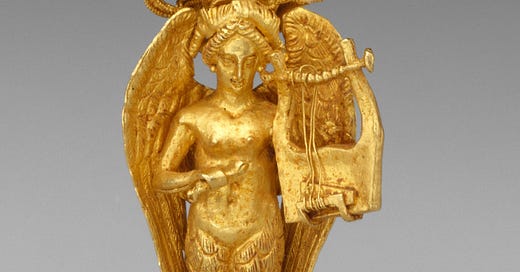Indus Script Generator, Medieval Mauryas, Amazonian Cities - Monday Cup Of Links #94
And Siren earrings!
Happy Monday!
Spring is here, but it feels awfully early for the Valentine’s Day candy to be replaced by Easter Candy in stores, but that’s what I see. Not complaining too hard; I found a bag of ‘crispy eggs’ from Ferrero Rocher and I did not know how hard I needed this in my life.
I completed editing about 50,000 words of my novel, and I’m so mad that there are three more sets of 50,000 words to edit. Epic novels are not the best of ideas, I gotta say. If it was a standard short novel, I’d be done by now (or three years ago). Anything I write subsequently is going to be much more tightly scoped and limited to 70,000 words at most.
The funny thing is this was supposed to be a short novel with a tight scope, and whenever I read my sources on this, it was limited to a chapter at best of Savarkar’s life. That’s what my first draft was, too. But then I had to be like “But what were each of them really like?” and “What were the trains like in Edwardian London?”. Then I found reality much more insane compared to anything I could have come up with, and I had to write it all down while having a baby and managing the ups and downs of tech life.
Onto our links!
Devanagari to Indus Script Generator
Yajnadevam claims to have deciphered the Indus Valley script. Here is one of his talks on the decipherment. There are many more, including mainstream media coverage, but this one is the most detailed in terms of technique used. He solved it like a cryptogram, matching the alphabet to the ones in Devanagari. I’ve read his paper and I’m more or less convinced, though I haven’t had the time to retrace his steps. I should probably do a deep dive here when I do that. I looked at some of the translations of major signs and have interacted with him on his Discord enough that I’m mindblown by the words in some of the seals.
What’s fun now is The Butter Thief has created a page where you can transcribe text from Devanagari/Roman script(IAST) into the Indus script
It’s pretty great, here’s my name in the Indus script!
The Amazon is not a virgin forest, it had large cities in it.
The assumption has always been that the Amazon is a virgin forest. All the climate change calculations have been based on that. But archaeologists have found geoglyphs (designs and images made on the ground with natural materials) at holy sites, and the roads connecting them deep in the Amazon. It seems like a civilization of a million people lived in what is now the Amazon forest between 700 BC and 900 AD, in what is called the Aquiry civilization.
We now have to rethink everything we know about the Amazon, including the history of civilization, and climate change concept that are based on the Amazon being a virgin forest.
Here’s a great interview of the Finnish archaeologist and historian Martti Pärssinen that goes into all this and more. It is in Spanish, so use Google translate.
The Medieval Mauryas
While we assume that the Mauryas died out circa 180 BCE, that was apparently only the main branch. There is some evidence to suggest other branches of the clan survived well into the medieval era.
Twitter user Keshav Damani alerted me to an article that expands on this. It says:
The epigraphs and numerous other evidence of Mauryas ruling in the Medieval period, suggest that there were many principalities of Mauryas which can be clubbed in at least three branches, viz. Malwa-Rajasthan branch, Mathura branch, Konkan-Khandesh branch.
Wow, that’s some long lineage!!
My writing from last week
Last week, I went into the ancestry and early life of Hyder Ali, based on Vikram Sampath’s book on Tipu Sultan. It turned out to be quite an interesting piece, and I added some entertaining contemporary bits, too, when I was trying to connect the events in the Carnatic to their memories and influences that make it to pop culture today, like Tamil movies and songs.
On Friday, I wrote a piece on something that had been bothering me for a while - what actually is the story of Savarkar’s escape? I tried to join the dots, and IMO it finally came down to sabotage that he didn’t get to take asylum in France.
Artifact: Classical Greek Gold Earring
This gold earring from the 4th century BCE from Greece is currently at the Met museum. I love how intricate it is for an earring! It has a siren - a part-bird, part-woman, who is playing a kithara (kithara is to the lyre as the violin is to the fiddle) and has a crown of snakes. I looked to see if people made such earrings even today, but no, the prevalent style right now does not include delicately carved sirens or cherubs.







Only 40% have been read so far.
"The funny thing is this was supposed to be a short novel with a tight scope, and whenever I read my sources on this, it was limited to a chapter at best of Savarkar’s life. That’s what my first draft was, too. But then I had to be like “But what were each of them really like?” and “What were the trains like in Edwardian London?”. Then I found reality much more insane compared to anything I could have come up with, and I had to write it all down while having a baby and managing the ups and downs of tech life."
Now I know why I have been waiting 11 years (and counting) for the latest Game of Thrones novel!
PS: Does it annoy anyone else that Substack comments don't have a "quote" feature? Seems to be a basic need.